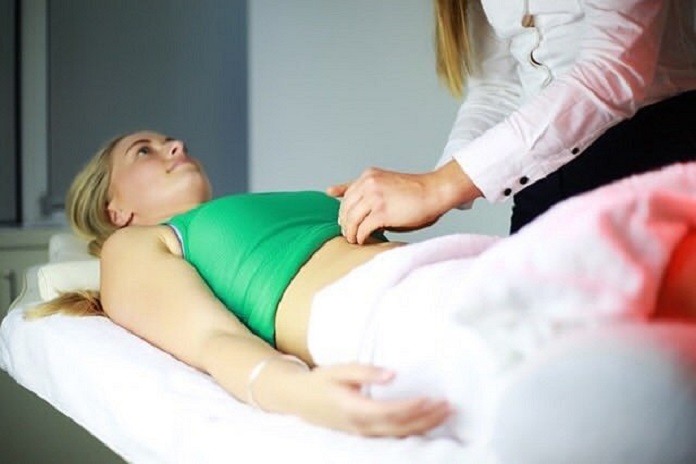Endometriosis is a painful, inflammatory disorder that commonly affects women during their reproductive years. The cause of endometriosis is believed to depend on estrogen levels, but the precise mechanisms remain unclear. Endometriosis occurs when the tissue that lines the uterus, known as the endometrium, thickens and grows with each menstrual cycle. Endometrial tissue growth continues outside the uterus and usually involves the ovaries, fallopian tubes, and pelvic tissues.
Pelvic pain is a major symptom associated with endometriosis that frequently occurs with menstrual periods. This is a sharp, stabbing pain that occurs in the area below the belly button. Other symptoms can include painful intercourse, bladder and bowel pain, and long-term pelvic pain.
Infertility is also associated with endometriosis. There is no definitive diagnosis, other than painful symptoms upon vaginal examination. However, studies have shown that ultrasonography provides better accuracy than MRI to diagnose endometriosis. Blood tests have been proposed, but none have been proven useful for a conclusive diagnosis.
The primary goals of therapy involve symptom relief, reduction or removal of tissue growth, restoration of affected areas, and prevention of endometriosis progression. Treatment options depend on whether the major problem is pain or a delay in conceiving, known as subfertility.
Standard treatment options for pain
- Drug therapies: pain medications (e.g. ibuprofen), hormone medications (e.g. oral contraceptives), and steroid medications (e.g. progesterone)
- Surgical options: laparoscopic surgery, excisional surgery, nerve interruption surgery, and barrier agents to prevent tissue growth on other organs
Standard treatment options for subfertility
- Drug therapies similar for pain, with the addition of assisted reproduction of ovarian follicles
- Surgical options: laparoscopic surgery and excisional surgery of tissue growth
Alternative treatments for endometriosis-related pain
Long-term administration of drug therapies remains a challenge due to side effects, such as irregular bleeding and fluctuating hormone levels. Others may opt out of surgical therapies due to high costs and endometriosis recurrence rates of 20 to 40 percent within five years.
As a result, complementary and alternative treatments for endometriosis with less risk and side effects have been researched. Chinese herbal medicine and acupuncture have been studied for their safety and effectiveness in endometriosis-related pain and subfertility.
Chinese herbal medicine
Studies of Chinese herbal medicine on endometriosis have suggested that specific combinations may decrease pelvic pain, while other combinations may help with subfertility. There are about 10 to 20 separate herbal ingredients used to prepare these mixtures either as a boiled extract, dried extract, pills, or capsules.
The active chemicals found in these ingredients are believed to work against inflammation and reduce pain, but how it relieves inflammation and pain is still unknown. A 2012 review assessed two studies that included 158 women for the effectiveness and safety of Chinese herbal medicine for endometriosis-related pain and infertility:
- One study compared herbal medicine to gestrinone, which is a hormone medication. There was no significant difference between herbal medicine and gestrinone for pain relief after laparoscopic surgery and total pregnancy rate.
- One study compared oral plus enema herbal medications to danazol, which is a hormone medication. Oral plus enema herbal medications resulted in significant relief of menstrual pain. For other endometriosis-related pain, herbal medications and danazol had no significant difference.
- Herbal medications had fewer side effects than hormone medications.
Acupuncture
Acupuncture may serve as another alternative treatment for endometriosis-related pain. Acupuncture may block the transmission of certain pain signals. A 2010 review evaluated one study that included 67 women and compared acupuncture to Chinese herbal medicine. Menstrual pain scores were lower in the acupuncture group. However, the improvement rate between ear acupuncture and Chinese herbal medicine did not differ for mild to moderate menstrual pain. Ear acupuncture for severe menstrual pain had no significant reduction. A comparison of acupuncture to standard therapies is required for future studies.
Possible alternative treatments for endometriosis include Chinese herbal medicine and acupuncture. These alternative options have fewer side effects than standard drug therapies. The presented studies require more participants and research to assess their potential roles in treating endometriosis.
References
- Brown J, Farquhar C. Endometriosis: an overview of Cochrane Reviews. Cochrane Database of Systematic Reviews 2014, Issue 3. Art. No.: CD009590. DOI: 10.1002/14651858.CD009590.pub2.
- Flower A, Liu JP, Lewith G, Little P, Li Q. Chinese herbal medicine for endometriosis. Cochrane Database of Systematic Reviews 2012, Issue 5. Art. No.: CD006568. DOI: 10.1002/14651858.CD006568.pub3.
- Zhu X, Hamilton KD, McNicol ED. Acupuncture for pain in endometriosis. Cochrane Database of Systematic Reviews 2011, Issue 9. Art. No.: CD007864. DOI: 10.1002/14651858.CD007864.pub2.



